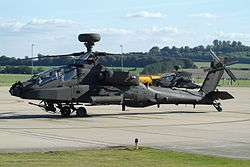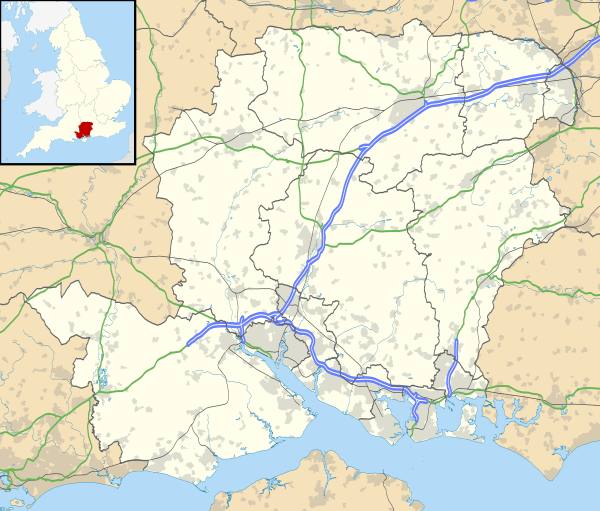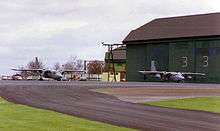AAC Middle Wallop
AAC Middle Wallop | |||||||||
|---|---|---|---|---|---|---|---|---|---|
| Middle Wallop, Stockbridge, Hampshire | |||||||||
 An Army Air Corps Westland Apache AH1 at Middle Wallop. | |||||||||
 Prepare | |||||||||
 AAC Middle Wallop Location within Hampshire | |||||||||
| Coordinates | 51°08′56″N 001°34′12″W / 51.14889°N 1.57000°WCoordinates: 51°08′56″N 001°34′12″W / 51.14889°N 1.57000°W | ||||||||
| Type | Army Air Corps airfield | ||||||||
| Site information | |||||||||
| Owner | Ministry of Defence | ||||||||
| Operator | British Army | ||||||||
| Controlled by | Army Air Corps | ||||||||
| Site history | |||||||||
| Built | 1940 | ||||||||
| In use |
Royal Air Force (1940–1945 and 1946–1957) Fleet Air Arm (1945–1946) Army Air Corps (1957 – present) | ||||||||
| Airfield information | |||||||||
| Identifiers | ICAO: EGVP | ||||||||
| Elevation | 90.5 metres (297 ft) AMSL | ||||||||
| |||||||||
| Source: Middle Wallop Defence Aerodrome Manual[1] | |||||||||


Army Aviation Centre (AAC) Middle Wallop is a British Army airfield located near the Hampshire village of Middle Wallop, used for Army Air Corps training. The base hosts 2 Regiment AAC and 7 Regiment AAC under the umbrella of the Army Aviation Centre. The role of 2 Regiment is ground training and 7 Regiment trains aircrew on AAC aircraft after they completed basic training at RAF Shawbury.
The base was previously under Royal Air Force control and it was then known as RAF Middle Wallop.
History
Early use
The base was opened as RAF Middle Wallop, a training school for new pilots in 1940. It was originally intended for bomber use, however with the Battle of Britain being fought, No. 609 Squadron RAF, flying the Supermarine Spitfire, and No. 238 Squadron RAF flying the Hurricane Mk1 were moved to Middle Wallop as part of 10 group RAF Fighter Command. In September 1940 604 Squadron RAF a specialist night fighter unit received the Bristol Beaufighter, equipped with four 20-mm cannon under the nose and improved Mark IV AI radio-location equipment. As one of the few Squadrons thus equipped, 604 squadron helped provide night time defence over the UK during the Blitz from late 1940 until mid-May 1941. In this time 50 air victories had been claimed by No. 604 Squadron, 14 by F/L John Cunningham.[2]
RAF Chilbolton was designated the relief landing airfield for Middle Wallop, until it became a fully fledged Fighter Station in its own right, as the Battle of Britain progressed.
USAAF use
Middle Wallop was also used by the United States Army Air Forces Ninth Air Force as IX Fighter Command Headquarters beginning in November 1943. Along with its headquarters mission, the airfield also hosted the 67th Reconnaissance Group being moved from RAF Membury in December 1943 to be in close proximity to IX FC Headquarters. The 67th Group flew the photographic versions of the Lockheed P-38 Lightning (F-5) and North American P-51 Mustang (F-6) to fly artillery-adjustment, weather-reconnaissance, bomb-damage assessment, photographic-reconnaissance, and visual-reconnaissance missions to obtain photographs that aided the invasion of the Continent.
After D-Day, both the 67th RG moved to its Advanced Landing Ground at Le Molay-Littry (ALG A-9) and IX FC Headquarters moved to Les Obeaux, France in late June 1944 ending the USAAF presence at Middle Wallop. During the American use, the airfield was designated as USAAF Station 449, ID Code: MW.
RAF/RNAS use
Middle Wallop returned to Royal Air Force use from July 1944 for No. 418 Squadron RCAF and its de Havilland Mosquito nightfighters.[3]
In January 1945, in an exchange with the RAF, Middle Wallop was transferred to Royal Navy use and became 'RNAS Middle Wallop'. HMS Flycatcher the HQ for the Mobile Naval Air Base organization then moved in from RNAS Ludham, which reverted to RAF use.[4] Five units were assembled at Middle Wallop, four transferring to Australia, Hong Kong and Singapore as planned; the last, MONAB X ("HMS Nabhurst"), remained in the UK following the end of the war in the Pacific.
In 1946 the Royal Air Force occupied Middle Wallop again. No. 164 Squadron RAF with its Spitfires came and were renumbered to No. 63 Squadron RAF. The following year No. 227 OCU, an Army Air Observation Post training unit, was moved to the airfield. This was renamed as the Air Observation Post School in 1950 and the Light Aircraft School in 1952.[3]
From mid-1953 to 1957, Middle Wallop was the home for No. 288 Squadron RAF with its Boulton Paul Balliols.
Army Air Corps use
In 1954 a Development Flight (CFS) with helicopters was formed there, this led to the Joint Experimental Helicopter Unit in 1955. On 1 September 1957, when British Army aviation became independent of the RAF, Middle Wallop transferred to the new Army Air Corps, and the School of Army Aviation was established. It changed its name to the Army Aviation Centre on 1 August 2009.[5]
Operational units
Flying and notable non-flying units based at Middle Wallop Airfield.[6][7][8]
British Army
- Headquarters Army Air Corps
- Army Historic Aircraft Flight – Auster AOP.9, Beaver AL.1, Chipmunk T.10, Scout AH.1, Sioux AH.1, Skeeter AOP.12
Joint Helicopter Command / Army Air Corps
- Army Aviation Centre
- 2 (Training) Regiment
- 676 Squadron
- 668 (Training) Squadron
- 7 (Training) Regiment
- 2 (Training) Regiment
- Army Flying Grading Flight – Tutor T1
- 667 (Development & Trials) Squadron – Apache AH1, Gazelle AH1 and Wildcat AH1
In Literature
The opening scene and several subsequent scenes in Victor Canning's 1972 thriller The Rainbird Pattern are set in the AAC.
References
![]()
Citations
- ↑ "Middle Wallop Defence Aerodrome Manual (DAM)". British Army. Military Aviation Authority. 4 September 2017. Retrieved 7 July 2018.
- ↑ 'Aces High' Shores & Williams, page 74
- 1 2 RAF Middle Wallop airfield
- ↑ "Flycatcher(2) Middle Wallop". Archived from the original on 26 September 2007.
- ↑ "Army Aviation Centre". Ministry of Defence. Retrieved 8 July 2016.
- ↑ "Selection process". The British Army. Retrieved 6 November 2017.
- ↑ "Historic Aircraft Flight". The British Army. Retrieved 6 November 2017.
- ↑ "AAC Structure". The British Army. Retrieved 6 November 2017.
Bibliography
- Freeman, Roger A. (1994) UK Airfields of the Ninth: Then and Now 1994. After the Battle ISBN 0-900913-80-0
- Freeman, Roger A. (1996) The Ninth Air Force in Colour: UK and the Continent-World War Two. After the Battle ISBN 1-85409-272-3
- Maurer, Maurer (1983). Air Force Combat Units Of World War II. Maxwell AFB, Alabama: Office of Air Force History. ISBN 0-89201-092-4.
- ArmyAirForces.com 67th Reconnaissance Group
External links
| Wikimedia Commons has media related to Middle Wallop airfield. |
.svg.png)